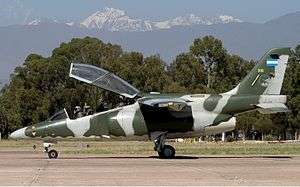FMA IA 63 Pampa
| IA-63 Pampa | |
|---|---|
 | |
| IA-63 in Mendoza, Argentina | |
| Role | Trainer aircraft |
| National origin | Argentina |
| Manufacturer | FAdeA |
| First flight | 6 October 1984 |
| Introduction | April 1988 |
| Status | In service |
| Primary user | Argentine Air Force |
| Produced | 1984-present |
| Number built | 27 |
|
| |
The IA-63 Pampa is an advanced trainer aircraft with combat capability, produced in Argentina by Fabrica Militar de Aviones (FMA) with assistance from Dornier of Germany.
Design and development
Preliminary design studies for a replacement for the Morane-Saulnier MS-760 of the Argentine Air Force started at the Fábrica Militar de Aviones (FMA) in 1978, with these studies resulting in selection of a proposal powered by a single Garrett TFE731 turbofan with high, unswept wings. At the same time the FMA signed a partnership agreement with Dornier to develop the new aircraft.[1]
Although influenced by the Dassault/Dornier Alpha Jet design, the Pampa differs in being a smaller aircraft, it is also single-engined and has straight supercritical wings rather than the swept ones of the Alpha Jet. It is constructed mainly of aluminium alloy, with carbon-fibre used for components such as the air intakes. The crew of two sit in tandem under a single-piece clamshell canopy.[2] The avionics systems are also simpler than the Franco-German aircraft, which has an important secondary combat role. The Pampa prototype first flew on 6 October 1984.[3]
Variants
- IA 63
Production of the initial series has been delayed and hampered by the state of the Argentinian economy, and as a result only 18 production aircraft have been built in the first batch (1988–90) and six in the second batch (2006–07) for the Argentine Air Force. First deliveries occurred in April 1988.[4] The 18 aircraft are in service, all modernized, with the IV Brigada Aérea (English: IV Air Brigade) at Mendoza for the advanced training role of Argentine pilots.[5]
- Vought Pampa 2000
In the 1990s, LTV/Vought selected the IA 63 as the basis for the Pampa 2000, which Vought entered into the Joint Primary Aircraft Training System competition for the United States Air Force.[6] The Pampa 2000 lost to the Beechcraft/Raytheon entry which became the T-6 Texan II.[7]
- AT-63 Pampa "Phase 2"
With the acquisition of FMA by Lockheed Martin the Pampa was upgraded with a new engine and a more advanced avionics package compatible with the A-4AR and weapons system. This new project was called AT-63 Pampa "Phase 2"(for attack trainer) and was marketed by Lockheed Martin. The only client is the Argentine Air Force.
- IA-63 Pampa GT "Phase 3"
A third batch of forty new units of the redesigned Pampa was announced by FADEA on 10 October 2013.[8] After a long delay, finally in 2015 a prototype of the third version of the IA-63 Pampa was introduced to the press. However, rampant inflation and a severe recession have made impossible for the Argentine government to finance the manufacturing of any of the promised planes. [9]
Specifications (IA 63)
Data from Jane's All The World's Aircraft 1988–89 [10]
General characteristics
- Crew: two
- Length: 10.93 m (35 ft 10¼ in)
- Wingspan: 9.69 m (31 ft 9¼ in)
- Height: 4.29 m (14 ft 1 in)
- Wing area: 15.63 m2 (168.2 ft2)
- Airfoil: Dornier DoA-7
- Empty weight: 2,821 kg (6,219 lb)
- Loaded weight: 3,500 kg (7,716 lb)
- Max. takeoff weight: 5,000 kg (11,023 lb)
- Powerplant: 1 × Garrett TFE731-2-2N turbofan, 15.57 kN (3,500 lbf)
Performance
- Never exceed speed: Mach 0.81 (at 9,500 m (31,170 ft))
- Maximum speed: 819 km/h (442 knots, 509 mph) at 7,000 m (22,965 ft)
- Cruise speed: 747 km/h (403 knots, 464 mph) at 4,000 m (13,125 ft)
- Range: 1,500 km (809 nmi, 932 mi)
- Service ceiling: 12,900 m (42,325 ft)
- Rate of climb: 30.2 m/s (5,950 ft/min)
Armament
- Guns: 1× 30 mm (1.18 in) Defa-Giat 554
- Hardpoints: 5 with a capacity of
- 400 kg (880 lb) on inboard underwing pylons
- 250 kg (550 lb) on fuselage centerline and outer wing pylons
See also
- Related development
- Aircraft of comparable role, configuration and era
References
- Notes
- ↑ Flores 1987, pp. 59—60.
- ↑ Flores 1987, p.64.
- ↑ Flores 1987, p.66.
- ↑ Taylor 1999, p.1.
- ↑ "Argentina to buy 40 more Pampas". Flightglobal.com. Flight International. 21 September 2011. Archived from the original on 31 March 2012.
Split between two Mendoza-based units, the 12 surviving Pampas from an original 16-aircraft batch have all been upgraded to near Series II standard. They are expected to be rotated through FAdeA's installations for re-engining, along with six newly-built IA-63s delivered between 2004 and 2008.
- ↑ Lambert 1992, p. 2.
- ↑ Warwick, Graham (21–27 February 1996). "Turboprop Triumph". Flight International. Vol. 149 no. 4511. p. 23.
- ↑ Graña, Juan (12 October 2014). "El Gobierno destinó más de u$s180 millones a una fábrica aeronáutica que aún no construyó un solo avión". infobae.com. Archived 16 March 2015 at the Wayback Machine.
- ↑ http://zona-militar.com/2015/09/22/numeros-imaginarios-y-numeros-reales-la-teoria-del-ia-63-pampa/
- ↑ Taylor 1988, pp. 3—4.
- Bibliography
- Flores, Jackson, (Jr). "The Pampa...A Tutor with a Teutonic Flavour". Air International, February 1987, Vol 32 No. 2. Bromley, UK:Fine Scroll. ISSN 0306-5634. pp. 59–66, 90.
- Lambert, Mark (ed.) Jane's All The World's Aircraft 1992–93. Coulsdon, UK: Jane's Defence Data, 1992. ISBN 0-7106-0987-6.
- Taylor, John W.R. Jane's All The World's Aircraft 1988–89. Coulsdon, UK:Jane's Defence Data, 1988. ISBN 0-7106-0867-5.
- Taylor, Michael J.H. Brassey's World Aircraft & Systems Directory 1999/2000. London:Brassey's, 1999. ISBN 1-85753-245-7.
External links
| Wikimedia Commons has media related to FMA IA 63 Pampa. |
- AT-63 Official page at Lockheed Martin website
- Global Security.org page
- Dintel GID Plane specifications